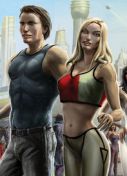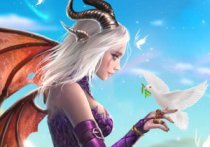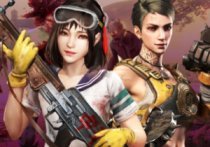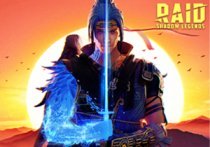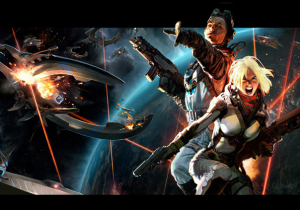Shroud of the Avatar: Forsaken Virtues Review
For every one thing I learn about SOTA, four more things come up that I do not know, do not understand, or could not figure out.
I’m a lifelong fan of the Ultima franchise, no matter how poor I am at the games. They are the creation of Lord British (Richard Garriott), and Shroud of the Avatar: Forsaken Virtues holds the identity of the world of Britannia (now New Britannia) without the official “Ultima” name attached to it. Shroud of the Avatar is a game that frankly, has filled me with quite a lot of conflict. I love the concept, I enjoy most of the game, but every time I find something that I love, I find myself confused by something else. You play the role of the Avatar, a person transported from another world to New Britannia – the same theme as other Ultima games. In the online mode, the game acknowledges there are multiple Avatars running around, and it’s all building towards prophecy. The Oracle will guide players to their class (Fighter, Mage, Ranger), but if you don’t like what she picks for you, you can go through her test again. Shroud of the Avatar also has an offline mode, but offline characters can never enter the online game and vice versa. For accounts with multiple characters, you will share a Virtue, guild membership, bank and housing lots (if any).
You will journey into a world built on The Three Principles and Eight Virtues used in the Ultima franchise (displayed here, with thanks to the Digital Antiquarian). Each major town is tied to one of these, and this is important to the story. Each of the three main possible starting areas has their own tragedy and horror occurring, and it’s up to you to figure out who is right and who is wrong. But before you delve into the land, you make a character. You have two genders and some fairly basic character customization options, where you can adjust the face, but not the body. Start on the Isle of Storms, where you do your character customization, and reach the Oracle. She’s a giant mechanical face that will ask you questions where you tell her how honest/courageous/loving you will be in your answers. These determine your fate, but again, you can re-do if that is your desire. Shroud of the Avatar also retains the traditional method of speaking to NPCs that the previous Ultima games had: keywords. You’ll click the keywords (underlined, or below the text bar) and it will bring up the next important bit of conversation, or lead you to a quest. The Companions of Truth, Love, and Courage are also in the game now and can accompany you in offline mode and comment on your adventures.
As far as a tutorial goes, there really isn’t one. The game will give you a handy guide or two to answer most of your questions, but there are no real tutorials outside of basic movement and controls. It barely holds your hand before it hurls you into the thick of actual gameplay. Shroud of the Avatar will dump you right into an area to start, and I played through two out of three of them. I started as a Wizard, and absolutely hated how slow going the power curve was. After ten hours, I was still barely killing things, and not certain where to put my time and energy into with all of the magic schools (Sun, Fire, Death, Air, Moon, Water, Life, Earth, Chaos) to consider.
I did learn a valuable, though vexing, lesson. You have torches, but in order to wield one, you have to use hand slot. So that means no shield, or no weapon at all if you specialize in two-handed weapons. Not a big fan of that. Moon Magic’s first spell is “Night Vision”, which lets you see in the dark. Everything looks like it has a green film over it, but at night it is absolutely indispensable. Make this one of your very first decisions, and you won’t regret it. As you explore the world you’re called to make some heavy decisions and while they don’t affect the gameplay, they do affect how the Oracle judges if you are living by the Principle associated with your character class. These choices don’t change how strong or weak you are, but they are fun to see how you affect the world around you. The game doesn’t really mention PVP much, but it is there, and there are NPCs that can remove your “Protection” and flag you for PVP. I saw a few PC-run towns that were Open PVP, but that’s not my cup of tea, so I kept going right on past them.
New Britannia is a world completely enthralled with this concept of Virtue. A mysterious threat is hovering over the land, and a world once consumed with Truth, Love, and Courage is now tainting what these Principles stood for. In the Mage story for example, you’re given a chance to betray the Elves you meet up with by poisoning and murdering them. I actually tried to do this, but the quest was not working. I could not make the choice I wanted to and just had to move on. The story is the best part of this game, which was written in collaboration with Tracy Hickman (who wrote some fabulous “Dragonlance” novels). There is no real “end game”, but once players see the end of the Episode 1 Quest, the threat will become a bit more clear, and give them an idea of where we’re going next.
This is a long tale, and it’s not going to be over anytime soon. Shroud of the Avatar takes a similar road to Guild Wars 2, in offering more story, not more raids and dungeons. Visually, it reminds me of slightly older MMOs or an Elder Scrolls title. I enjoy the aesthetic and all of the areas are quite pretty. From the sakura blossoms in Ardoris to the crimson of Blood River, it all looks very much alive. The graphics change when players enter the overworld, turning into a more top-down retro look. Players can see important locales (player towns, towns, adventure maps) with a banner hovering over them with an ancient language. Adventure Zones are labeled by a difficulty color (Green is too weak, Red is too strong, Yellow is just right) in addition to a Tier number, and a pole with skulls on it to match that. I do feel like this should have a color-blind option, since players can’t really tell by the number of skills how they match up to an area.
There’s also the matter of land. Players in Shroud of the Avatar can own a plot of land and a home, which is pretty damn expensive. The cheapest one is 120,000 gold, with a daily rent of 500g, as well as a weekly tax of 1 Gold Crown of the Obsidians. These coins are a rare drop in almost any activity, but you can also buy them in the Add-On Store. So if you want to own land, you better be prepared to grind and work forever it seems. The City Lot Property Deed is 800,000 gold. There is one more part of the game I think should be made clear, and that’s the topic of pay-to-win. It is very easy to buy gold for this game, and the real estate market in Shroud of the Avatar is no doubt flourishing with people already making thousands of real dollars off of it. In the early days, you could support the Kickstarter of this game, and some of the higher donation marks would let you own a rent-free castle. This deed as far as I’m aware, can be sold, traded, and transferred to other players. It cost 12,000 dollars, but you could have a castle if that was your desire. It feels like everything in this world has a dollar value attached to it, much in the same vein as EVE Online. Can you play this game and enjoy it without owning a house, village or castle? Of course. I do just fine as a “Vagabond”, wandering the land on my own two feet. I do not feel like owning land makes you any better or stronger at Shroud of the Avatar. It does not give you skill buffs, better gear, anything of the sort.
But let’s be honest: Owning a castle is cool. I see a great future in digital real estate for Shroud of the Avatar, people buying up plots of land and flipping them for a real-life profit. It’s not a necessary part of the game, but it does exist. I know of one website already that is a trusted partner with Portalarium, where you can buy in-game gold as well as items that are no longer available (but acquired from players who owned them). I suppose one way to beat the Gold Selling market is to have one on retainer. Sure, you don’t “need” a house, but it’s in the same vein as a lootbox. People are going to “want” it, and having an avenue to spend real money on gold to purchase housing, I see a slippery slope forming. Full Disclosure: Once I saw a website that was paired as a trusted seller/partner, I invested 24 bucks in in-game gold (100k, the cheapest bundle offered) just to see if it affected my overall gameplay. Did it make things better, faster? Turns out it did. I was able to buy much stronger player-crafted gear, which let me survive longer, deal more damage, and buy huge piles of potions to keep me going in certain situations.
The combat is mostly cut-and-dry for Shroud of the Avatar: Forsaken Virtues. Combat is not anything out of the ordinary for your average MMO: You enter the aggro range, switch from your passive abilities to your attack deck (Z Key at default), and use abilities and auto-attacks til they are dead. Loot, move on. I will say that I love that wild animals will attack humanoid enemies, and wild animals don’t drop gold or equipment. Only humanoids drop loot and gold while animals drop the appropriate animal parts after skinning them. You regen faster in the passive stance, so make sure to always swap back when you’re done. Enemies are color-coded for strength like zones are. Players have HP (Health) and Focus (Abilities), and an absolute ton of skills to pick from: blades, polearms, long-range weapons, bludgeon weapons, shields, the magic schools, light/heavy armor, and a set of four strategy skills (Taming, Subterfuge, Tactics, Focus). The beauty of this system is no matter what you start as, you can utilize any of the skills. Now, heavy armor does typically come with a Spell Fizzle probability (a chance that every cast can fail right off the bat), so if you go with a warrior in heavy armor, be aware of this possibility. It will be clearly listed on all armor you see in-game. This combat engine does have something interesting going for it. All skills have a cooldown, that’s not new. However, you can use a skill during this cooldown for an increased Focus cost (highest I managed to go was 4 uses). It will also increase the time it takes to reset back to the normal cost. This is called a “Locked Glyph”, an ability with a cost/cooldown.
There’s a more advanced technique, called “Deck Building”. You can learn how to do it at most any trainer. You build a custom deck of certain abilities you want to use (you can reset your “hand” with one of the Focus powers), and they’ll appear on your hotbar. The advantage of this style is, there are no Cooldowns. In a Deck, you can use an ability as soon as you draw it again. You can assign Glyphs to only appear in certain parts of your hotbar as well, for muscle memory purposes. I like this idea as a different way to approach the game, and it’s clever, but it wasn’t the way I wanted to approach combat. The other “advanced” technique is free attack. Normally whenever you’re in range and a weapon is drawn, as long as you are facing the enemy, you’re swinging. With “free attack” you swing with the LMB. I can see why this might be useful, but I stuck with regular auto-attacks. On the topic of skills, I’ll explain why I swapped from a Wizard to a Warrior, and why as a Warrior I took a few spell kits. All characters have Strength, Dex, and Intel. Intel is the primary Wizard stat, I looked around for a passive trait to increase it. It’s hidden in the Focus tree, with a prereq of Level 20 “Heightened Awareness”, which is another passive. So you just have to use abilities and ultimately wait it out and hope.
When I used a Warrior, I was able to unlock “Blade Speed” with Level 20 “Bladed Combat” which was easily done by spamming my blade skills. Earth Magic gave me “Strength of Stone” as an enchant to increase my strength, plus “Sympathy of Stone” which is a passive Damage Resistance/Avoidance, though I had to wait for “Train Strength” behind the Tactics wall of Level 20 “Healthy”. That was easy since all I did was stand in combat and fight things all the time. The road to power was infinitely easier as a Warrior. A Wizard just felt hopeless and slow, and I had to stop all the time and rest and wait. Higher-tier Wizard skills also have reagents, and a chance to consume them with each cast. Warriors just have to have a weapon and at least one hand. I imagine high-level adventuring Wizards can truly deal staggering amounts of damage, but the wait to even be decent at the task did not feel worth it.
Each of these trees, be they Crafting or Adventuring, is broken into these subsections and each has their own tree, with predictable requirements (connected skills requiring x level). Thankfully, all skills only take 100 gold to learn, and that’s chump change. You gain 100 gold just by talking to a town crier in a new town (including player run towns). The higher-tier skills must be learned from a master of that art, which usually means wandering far away. I traveled the entire continent just to learn Blade master skills and decided to just stay there instead of continuing the story, as it would be easier to grind there, learn what I need to know, and then resume my quest.
Crafting is pretty easy in this game though. Go to a table where you would use the requisite skill, bring the mats, craft the starting recipe. You can find other recipes in the wild alongside what you learn from trainers. The system is easy to use, but actually gathering the mats in the wild is a tedious, slow affair. Only a few times did I find a map where I could easily farm something at a decent rate. This is another point where simply having a ton of gold can make life a lot easier.
Using abilities gives XP towards leveling them (and passives level by using skills associated with them) but here is where things get a little complicated. As you talk to NPCs, complete quests, and kill enemies, you gain a pool of Shared Exp. This goes to all the skills you use, as anytime you use a skill for anything, it has a chance to increase a little meter for it (displayed and managed on the side of the screen). This will probably see you leveling skills you don’t really want to use that exp on, like crafting/gathering when you’re skinning animals after killing them, and ultimately wasting that exp. So you can stop that from happening by clicking the skill and pausing it. It was hard to tell at first if I was getting stronger at all. Slowly picking up new armor, increasing the power of my skills, learning new skills, this led to the “hidden” stat, Adventurer Level. It’s not clearly displayed, but if you hover over your name, it will be seen.
It Keeps On Spinning, There’s No Beginning: Fair (2.5/5)
Shroud of the Avatar: Forsaken Virtues does a lot that I sincerely enjoy. The story is top-notch; the world, while not a breathtaking AAA venture, is still visually appealing; the background music is soothing. But for every positive, there seems to be a glaring negative. The community was helpful and friendly when I stumbled upon people. All of my adventures were solo though. While I do enjoy the visuals of the game, there’s a truly vexing hit-detection/collision effect anytime you walk near any NPC in the game. You’ll go from moving at a normal pace to almost a dead stop immediately, then slowly start walking again. It also occasionally happens on the overworld map with trees and bushes, but this seems to be far less finicky. Running and Jumping at the same time does not work very well, but standing still and jumping is fine. There was also frustration in the loot: 35 hours in and I’m still picking up the same rusty swords, shoddy bows, and small amounts of reagents. I was hoping to find something even equippable but after the first few hours that stopped being the case. I think the biggest problem I had was in the questing system. I said earlier that a quest I tried to complete on my Wizard only half-worked, then did not work at all, leaving me to do the right thing, when I wanted to poison people instead.
Quests that I could pick up multiple times (and not turn in), quests not working until I restarted, quests that did not work at all, and they can’t remove them from your journal. You can hide quests in the HUD, but that’s about it. I hope that is changed in the near future. I enjoyed simply getting lost in this world and exploring it (which I did, several times in fact, not always on purpose), but there are some systems and decisions that made no sense. When I left the first town and sallied forth on the next part of my journey, about four or five hours into the game, I’m tasked with heading to a town to speak to an NPC. “No problem,” I think to myself as I head onto the world map. When I get there, there’s a Tier IV Siege in progress. Towns (PC-owned and otherwise) can be besieged by an evil Cabal, and it’s incredibly powerful at that level. They’ll leave on their own, but I don’t have time for that. Luckily you can run through these. If it’s showing red, don’t listen to the game and think you have to fight your way through. Run and run fast. Despite a lot of these issues, I enjoy the game a lot and am looking forward to finishing the first episode. I’m close to 35 hours in at this point and still have not completed the story. That’s not what I came to the game for, I came for an adventure and certainly gained that. The ability to buy gold that easy and how it will affect the housing/equipment market was unsettling, and this being the release before launch baffled me with the number of issues I wound up having.
Articles You May Enjoy
- Amsgames Adds Golden Black to Kickstarter
- Golden Black is an ambitious RTS MMO game which proposes a unique gaming experience that mixes classic RTS game mechanisms with MMO, MOBA, RP...
- Atlantica Online Introduces Dragon Trial - New Time Attack Game Mode
- Nexon America’s strategic turn-based MMORPG, Atlantica Online, has just unleashed Crucible of the Dragon, the latest content update to the g...


